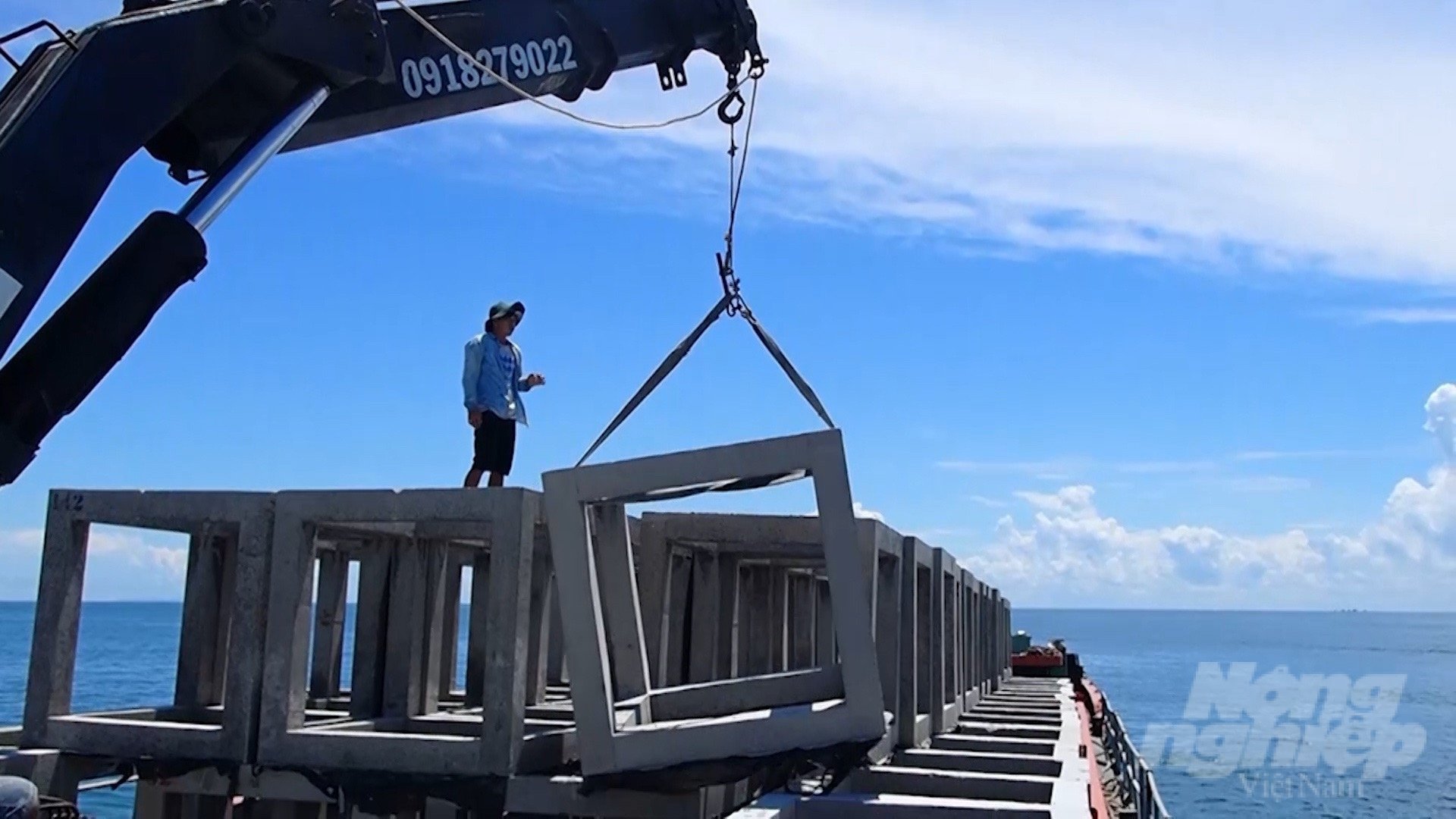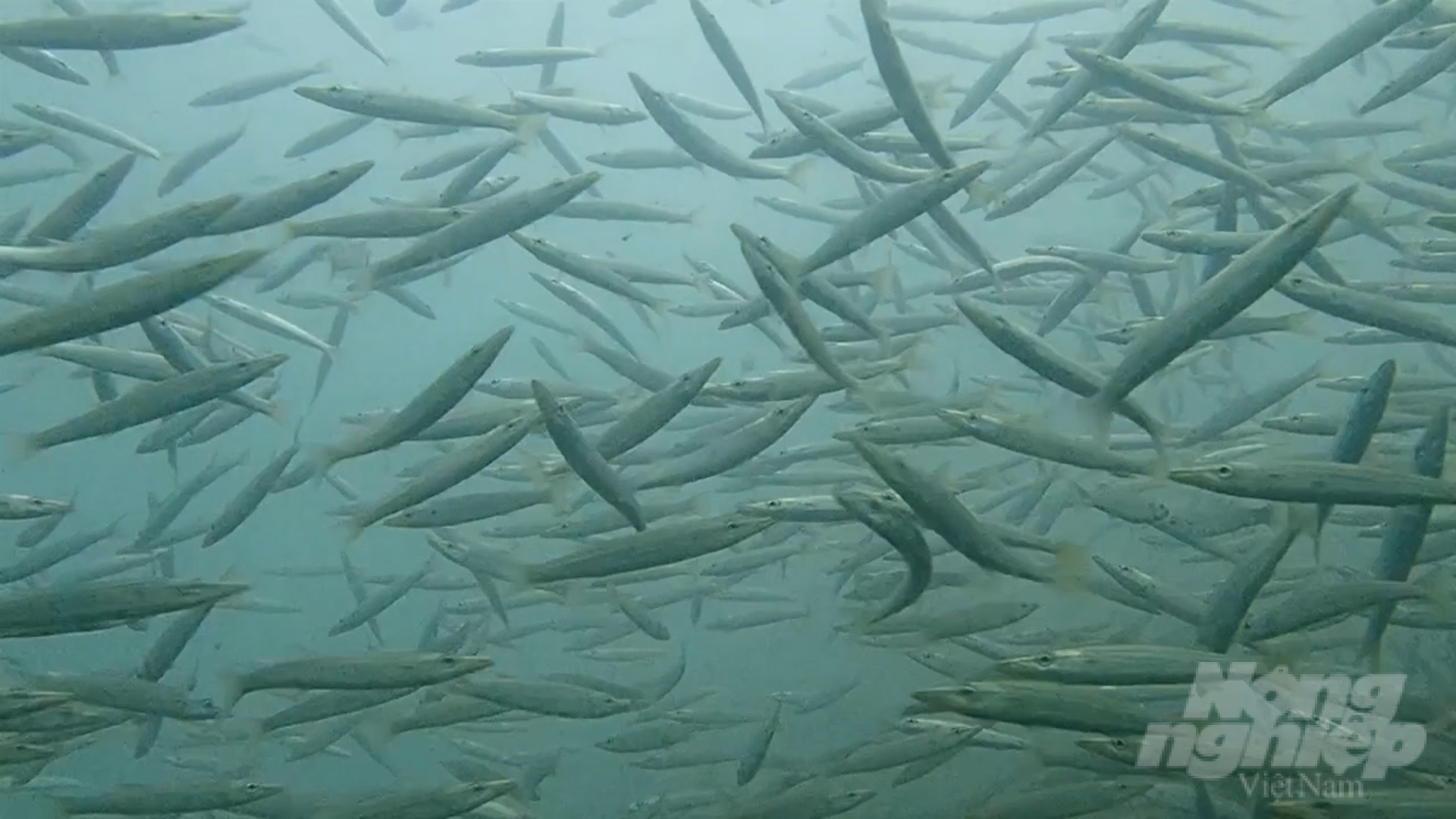November 6, 2025 | 22:15 GMT +7
November 6, 2025 | 22:15 GMT +7
Hotline: 0913.378.918
November 6, 2025 | 22:15 GMT +7
Hotline: 0913.378.918

Ca Mau province's Department of Agriculture and Rural Development and the Government of Thailand co-organized the release of 500 concrete reef blocks into the West Sea. Photo: Trong Linh.
After over 3 years of implementing the Project on "Releasing artificial reefs to protect and regenerate aquatic resources in combination with tourism development in the waters of Ca Mau province", 900 blocks of concrete reefs have been dropped into the sea as shelters for the diverse marine life.
Mr. Nguyen Viet Trieu, Deputy Director of the Ca Mau province's Sub-Department of Fisheries reported: "Footage and photos of the 900 blocks of concrete reefs taken by divers within 5.6 kilometers off the coast of Ca Mau province have demonstrated the relative success of the project. Artificial reefs have provided marine species with a site to breed and inhabit away from destructive fishing gears, thereby restoring aquatic resources.

After over 3 years of implementing the Project on "Releasing artificial reefs to protect and regenerate aquatic resources in combination with tourism development in the waters of Ca Mau province", 900 blocks of concrete reefs have been dropped into the sea as shelters for the diverse marine life. Photo : Trong Linh.
With support from the Government of Thailand since 2019, Ca Mau province has released 500 concrete reef blocks into the ocean area to the west of this province to provide shelter for marine species. Following its initial success, Ca Mau province released an additional 400 blocks of concrete reefs as marine shelters under the program for "protection and development of aquatic resources ".
“In addition to the release of artificial reefs, their presence has made over 1.8 square kilometers of ocean area safe. Before we released the artificial reefs, only a few species of fish and shrimp were recorded after surveying the sea. However, after releasing the reef, we discovered 78 species, with fish having the highest density of 48 species. These findings have proven that the ecosystem is gradually recovering", explained Mr. Trieu.

After the artificial reefs were released, the number of commercial species in the area skyrocketed, with 97 species, including 62 species of fish, 15 species of crustaceans and 20 species of molluscs. Photo: Trong Linh.
The fishery resources in the fishing grounds have greatly improved, according to the surveys on the income effectiveness of local fishermen conducted before and after the release of artificial reefs. Additionally, income from fishing activities in the area has increased noticeably. Namely, the average catch has increased by 15.4% per trip, and the profits increased by 6, 5 million VND per trip; the average catch from cage farming increased by 27.4% per trip; the average catch of squid fishing increased by 16.1% per trip; the output of squid from snail-trapping increased by 9.58% per trip.
Before releasing the artificial reef, Ca Mau province was only able to identify 40 commercial species in including 25 species of fish, 8 species of crustaceans and 7 species of molluscs. After the artificial reefs were released, the number of commercial species in the area skyrocketed, with 97 species, including 62 species of fish, 15 species of crustaceans and 20 species of molluscs.

The fishery resources in the fishing grounds of Ca Mau province have greatly improved after the artificial reefs were released into the ocean. Photo: Trong Linh.
The appearance of predatory fish species such as cobia, mackerel, queenfish, barracuda, grouper, snapper, etc. shows that the natural food chain in the reef ecosystem is slowly recovering. Several species of fish with significant habitat value such as butterfly fish, paradise fish, white-tailed queen fish, etc. These species can help develop scuba diving and recreational fishing in the near future.
The awareness of the members within the group for "Co-management on the protection and development of aquatic resources, orientation for sustainable fishing" has been raised significantly. As a result, the fishing practices of local people have been adjusted to accomodate the protection of aquatic resources for sustainable exploitation.
On the other hand, Ca Mau province is determined to fight illegal IUU fishing by many forms of propaganda and advocacy, including administrative sanctions. According to Mr. Le Van Su, Vice Chairman of Ca Mau Provincial People's Committee, Ca Mau province will continue to strictly control fishing vessels entering and leaving its ports; strengthen control of unregulated fishing activities at sea.
Translated by Nguyen Hai Long

(VAN) More than 400 experts from domestic and international organizations attended the ACT Con 2025 conference, which aimed to connect technology developers with frontline conservation teams.

(VAN) Food irradiation technology is an innovative solution that extends shelf life and acts as a ‘golden visa’ enabling Vietnamese agricultural products to access the world’s most demanding markets.

(VAN) At Dinh My commune (An Giang province), Loc Troi Group recently organized Mini Expo 2025 under the theme ‘From technology to practice – Comprehensive cultivation solutions for crops.’
/2025/11/04/2510-4-162016_246.jpg)
(VAN) The launch of the 'Carbon for Good' project in Lai Chau opens up a new direction in forest management and protection, laying the foundation for developing carbon credits.

(VAN) Hai Phong is implementing a comprehensive greenhouse gas inventory program, promoting sustainable and eco-friendly development.
/2025/11/01/5020-0-nongnghiep-235014.jpg)
(VAN) According to the FAO Representative in Vietnam, innovation for a sustainable food future must stem from fresh ideas of young people who dare to think differently.

(VAN) The adoption of LED lighting technology in fishing operations is expected to help local fishermen cut fuel costs, boost catch efficiency, and progressively modernize their fishing fleets.